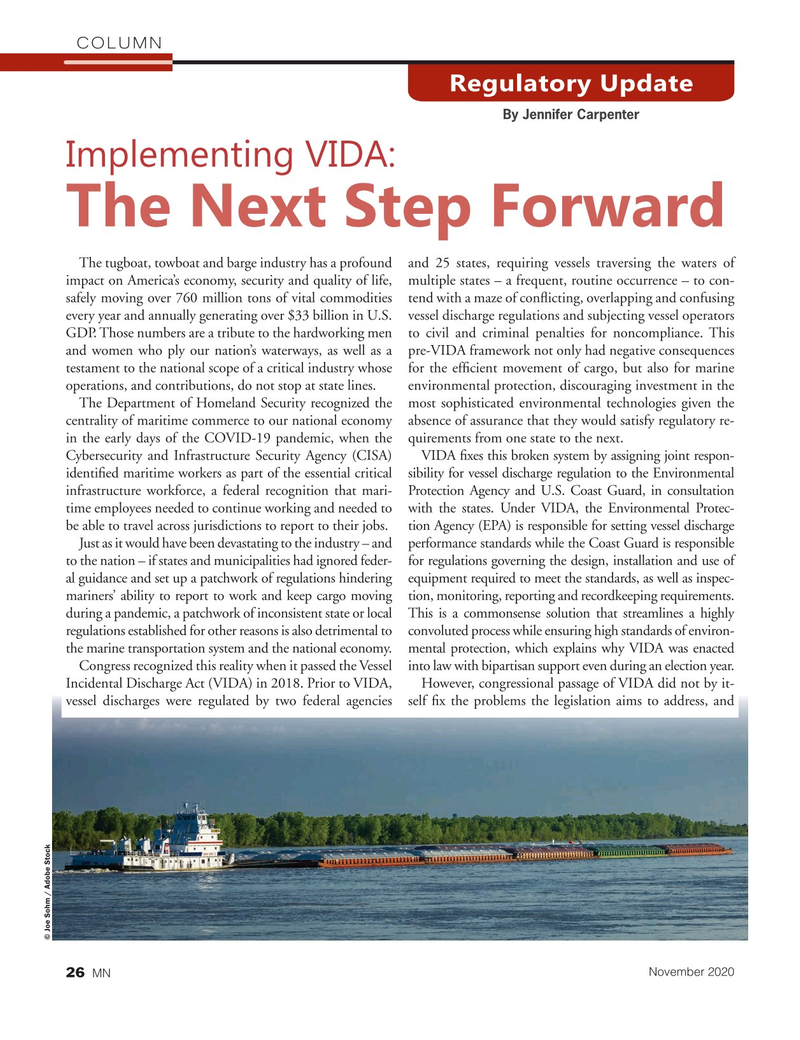
Page 26: of Marine News Magazine (November 2020)
Workboat Annual
Read this page in Pdf, Flash or Html5 edition of November 2020 Marine News Magazine
COLUMN
Regulatory Update
By Jennifer Carpenter
Implementing VIDA:
The Next Step Forward
The tugboat, towboat and barge industry has a profound and 25 states, requiring vessels traversing the waters of impact on America’s economy, security and quality of life, multiple states – a frequent, routine occurrence – to con- safely moving over 760 million tons of vital commodities tend with a maze of con? icting, overlapping and confusing every year and annually generating over $33 billion in U.S. vessel discharge regulations and subjecting vessel operators
GDP. Those numbers are a tribute to the hardworking men to civil and criminal penalties for noncompliance. This and women who ply our nation’s waterways, as well as a pre-VIDA framework not only had negative consequences testament to the national scope of a critical industry whose for the ef? cient movement of cargo, but also for marine operations, and contributions, do not stop at state lines. environmental protection, discouraging investment in the
The Department of Homeland Security recognized the most sophisticated environmental technologies given the centrality of maritime commerce to our national economy absence of assurance that they would satisfy regulatory re- in the early days of the COVID-19 pandemic, when the quirements from one state to the next.
Cybersecurity and Infrastructure Security Agency (CISA) VIDA ? xes this broken system by assigning joint respon- identi? ed maritime workers as part of the essential critical sibility for vessel discharge regulation to the Environmental infrastructure workforce, a federal recognition that mari- Protection Agency and U.S. Coast Guard, in consultation time employees needed to continue working and needed to with the states. Under VIDA, the Environmental Protec- be able to travel across jurisdictions to report to their jobs. tion Agency (EPA) is responsible for setting vessel discharge
Just as it would have been devastating to the industry – and performance standards while the Coast Guard is responsible to the nation – if states and municipalities had ignored feder- for regulations governing the design, installation and use of al guidance and set up a patchwork of regulations hindering equipment required to meet the standards, as well as inspec- mariners’ ability to report to work and keep cargo moving tion, monitoring, reporting and recordkeeping requirements. during a pandemic, a patchwork of inconsistent state or local This is a commonsense solution that streamlines a highly regulations established for other reasons is also detrimental to convoluted process while ensuring high standards of environ- the marine transportation system and the national economy. mental protection, which explains why VIDA was enacted
Congress recognized this reality when it passed the Vessel into law with bipartisan support even during an election year.
Incidental Discharge Act (VIDA) in 2018. Prior to VIDA, However, congressional passage of VIDA did not by it- vessel discharges were regulated by two federal agencies self ? x the problems the legislation aims to address, and © Joe Sohm / Adobe Stock
November 2020 26 MN

 25
25

 27
27
